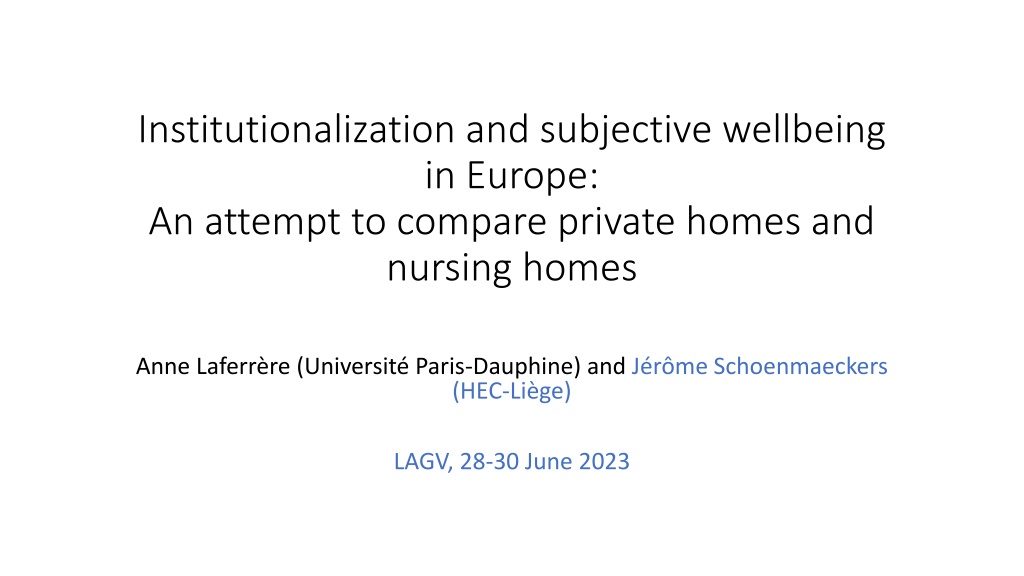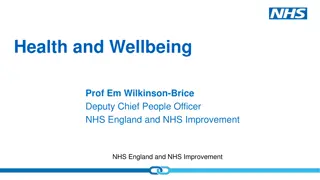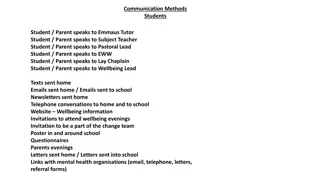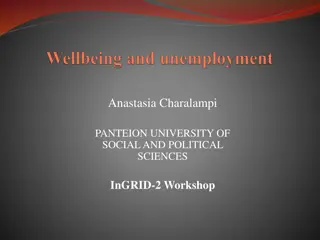Comparative Analysis of Institutionalization and Subjective Wellbeing in Europe
This study explores the impact of institutionalization on subjective wellbeing in Europe, comparing private homes and nursing homes. The research examines the desire to avoid nursing homes, especially heightened by the COVID-19 pandemic, and investigates the wellbeing of older Europeans in different care settings. By analyzing data from SHARE surveys, the study aims to identify factors influencing quality of life for individuals with limitations in daily activities.
Download Presentation

Please find below an Image/Link to download the presentation.
The content on the website is provided AS IS for your information and personal use only. It may not be sold, licensed, or shared on other websites without obtaining consent from the author. Download presentation by click this link. If you encounter any issues during the download, it is possible that the publisher has removed the file from their server.
E N D
Presentation Transcript
Institutionalization and subjective wellbeing in Europe: An attempt to compare private homes and nursing homes Anne Laferr re (Universit Paris-Dauphine) and J r me Schoenmaeckers (HEC-Li ge) LAGV, 28-30 June 2023
Introduction (1) Statement: Desire to age in place avoiding nursing home (NH) Recent COVID-19 pandemic increased this willingness (Achou et al., 2022) Even before the pandemic, excess mortality observed in NH in some European countries (Flawinne et al., 2023) but before the end of life, link between housing choices and wellbeing is also important and less explored Are older Europeans really better off at home than in care institutions?
Introduction (2) Extension of B ckerman et al. (2012) research in Finland on differences in quality of life of people institutionalised Higher levels of subjective wellbeing for Finns in old-age homes Some people living at home are frail and should really be living in old-age institution (subsidized) but because of the queues for that particular mode of living, they are living at home with a decreased quality of life Using 5 pre-COVID SHARE waves, we extend in three ways: 15 countries Selection of an a priori comparable sample of people with already at least one limitation in the activities of daily living Addition of propensity score matching methods to OLS and ordered probit models
Data (1) Data from SHARE survey Waves 4 to 8 (pre-COVID), from 2010 to 2020 65+ ADL >= 1 (bathing, eating, ) We keep a maximum of countries to point to good practices We leave aside countries such as Greece where NH are very few Leaving aside observations with missing values 20,088 observations (5.4% in NH)
Data (3) The two main variables in SHARE 1) measuring well-being: We are also interested in how people think about their lives in general. On a scale from 0 to 10 where 0 means completely dissatisfied and 10 means completely satisfied, how satisfied are you with your life? . 2) NH defined as : A nursing home provides all of the following services for its residents: dispensing of medication, available 24-hour personal assistance and supervision (not necessarily a nurse), and room & meals . + A housing complex with services for older people (residential home or sheltered housing)
Data (4) : Life satisfaction of the 65+ (scale from 0 to 10) in fifteen European countries Mean 6.75 6.45 6.73 Std. Err. 0.02 0.08 0.02 Private home Nursing home All
Data (5): Difference in satisfaction by countries Percentage living in Nursing Home (%) Both NH & PH (mean; s.d.) Nursing Home (mean; s.d.) Private Home (mean; s.d.) Large differences of satisfaction between countries Countries Denmark Netherlands Sweden Austria Belgium France Germany Luxembourg Switzerland Italy Spain Portugal Czech Rep. Estonia Slovenia All 7.71 (2.08) 7.49 (1.47) 7.60 (2.07) 7.16 (2.19) 7.31 (1.81) 6.61 (2.00) 7.00 (2.08) 7.02 (2.10) 7.84 (1.83) 6.25 (2.41) 6.53 (2.35) 6.17 (2.52) 6.58 (2.27) 5.76 (2.40) 6.31 (2.19) 6.73 (2.26) 7.08 (2.20) 6.84 (2.01) 6.93 (2.33) 6.84 (2.41) 6.81 (2.28) 5.97 (2.44) 6.46 (2.60) 6.78 (2.04) 7.62 (1.94) 3.59 (3.50) 6.00 (2.11) 5.00 (2.39) 6.06 (2.87) 5.53 (3.20) 5.74 (2.49) 6.45 (2.56) 7.80 (2.05) 7.56 (1.38) 7.66 (2.04) 7.18 (2.17) 7.36 (1.75) 6.65 (1.97) 7.03 (2.04) 7.05 (2.10) 7.87 (1.81) 6.31 (2.35) 6.55 (2.37) 6.21 (2.52) 6.61 (2.23) 5.77 (2.38) 6.33 (2.18) 6.75 (2.24) 11.7 10.5 7.6 6.3 8.7 4.9 5.4 12.3 10.4 2.1 3.1 2.7 5.2 2.3 3.4 5.4 Higher share of people aged 65+ with a limitation in ADLs living in NHs in the Northern countries Larger difference in LS between NH and private home in Italy and Portugal More robust analysis needed to conclude to NH leads to under- satisfaction
Data (6): Difference in satisfaction by covariates Both NH & PH at time t (mean) Nursing Home at time t (mean) Private Home at time t (mean) Covariates SSE variables (+ income, wealth) Socio-economic characteristics Men 6.85 6.66 6.70 6.71 6.84 6.57 6.84 7.10 6.21 6.56 5.67 6.42 6.70 6.37 6.43 6.82 6.88 6.67 6.72 6.72 6.86 6.59 6.86 7.12 Sex Women 65-74 75-84 Health variables (+ IADLs, SPH, mobility issues, health conditions issues) Age 85+ Low Education Medium High Health characteristics Family variables 1 or 2 3 or 4 5 or 6 Family characteristics 7.00 6.20 5.70 7.02 6.26 5.67 7.00 6.20 5.70 ADLs Yes No 6.91 6.53 6.46 6.72 6.84 6.73 6.49 6.27 6.30 6.45 6.61 6.45 6.53 6.92 6.48 6.73 6.85 6.75 More robust analysis needed to conclude to NH leads to under- satisfaction In couple 0 Children 1-2 3+ All
Results (1): OLS OLS models of the life satisfaction rates (effect of being in NH) All models control for demographics (age, sex, number of children, and the presence of a spouse or partner, country and wave fixed effects)
Results (2): Matching methods Above a certain level of disability it is difficult to stay at home, and the selection into nursing home may be linked to unobservables it is not because I live in a NH that I feel worse, but because of my unobserved level of disability To get closer to a causal effect of nursing homes on satisfaction, it is important to control for the possible simultaneous determination of health and housing arrangement we use a propensity score matching method. That is, every individual in a nursing home is matched to a set of individuals living at home with similar observable characteristics. It allows to condition on sufficient observable information to obtain a counterfactual against which to measure the effect of being in a nursing home.
Results (3): ATT by regions and countries To match similar individuals from the two groups so that the differences in outcomes (here self-reported life satisfaction) of these matched pairs can then be attributed to the treatment, i.e. being in a nursing home. No functional form of outcome equation + CIA assumption Kernell algorithm + exact matching Cet.par people feel worse in NH than in private homes
Results (4): Heterogeneity of ATTs Strongest impact on men and youngest residents (but driven by South) No effect from number of ADLs a contrario useful role of NH in cases of heavy dependence More difficult if still partner or children Groups of countries Central -0.462** -0.097 -0.322 -0.100 -0.330* -0.148 -0.421 -0.266 -0.681** -0.180 0.065 -0.377** -0.597** South -1.405*** -0.585 -1.933*** -1.190** -0.332 -0.418 -0.722 -0.880 -1.989*** -0.457 -0.777 -1.481*** -0.426 East -0.205 -0.321 -0.212 -0.060 -0.232 0.377 -0.059 -0.254 -0.622 -0.064 no match -0.256 no match Covariates North -0.632** -0.079 -0.480 -0.383 -0.381 -0.086 -0.224 0.036 -0.928*** -0.112 0.165 -0.342 -0.598** All Men -0.669*** -0.199* -0.770*** -0.373** -0.264* -0.044 -0.314 -0.384* -0.893*** -0.187* -0.137 -0.409*** -0.527*** Sex Women 65-74 75-84 Age 85+ 1 or 2 3 or 4 5 or 6 Yes No ADLs In couple 0 Children 1 or 2 3 or +
Conclusion This paper looked at whether people rate their quality of life lower living in a nursing home than in a private home Using simple OLS, people do not seem to be less happy in nursing homes (except for Italy) Using matching methods, more definite negative effect of the life in NH Margin for improvement of the care delivered in NH Differential negative effect is worse for men, for younger people, for those with more children or with a spouse important psychological effects beyond various local care practices improvement in NH management could be to make NH more open to non- professional carers such as family members Possible extension of this work would include data on out-of-pocket care and accommodation expenses in NH and in private homes























